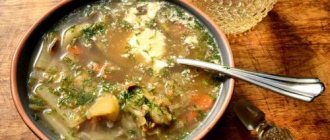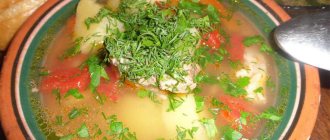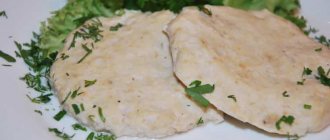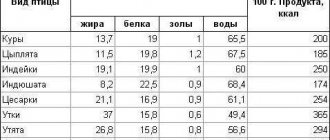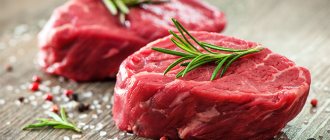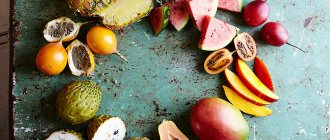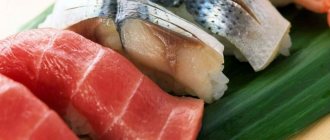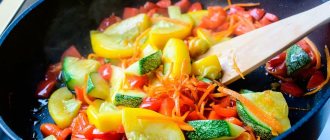Fish in batter
Cut the carcass into large strips along the entire width along with the ridge. Then the finished piece is eaten with your hands, separating the pulp from the bones - they are large, hard, there are not many of them - there should be no inconvenience. As an option, buy portioned boneless fillets, cleaned of entrails, and cut them into smaller portions. In both cases, cod, pangasius, pollock, hake, halibut and other white varieties are suitable. The easiest option for deboning is to dip a piece in flour, then in a beaten egg and place it in a frying pan with butter. But battered fish recipes also suggest more interesting mixtures. In addition to the two usual ingredients, you can also beat in a bowl: – Sour cream + finely grated onion + salt. – Light beer + spices. – Lenten version without eggs: water + soda + some unusual flour – pea, corn, buckwheat. – For variety: grate hard cheese/a couple of raw potatoes, or add white wine. Cooking possibilities must also be taken into account. – For baking in the oven or frying in a frying pan, make the mixture liquid so that it flows down the spoon. – For grilling, the dough must be made viscous – a little thicker than sour cream.
Ingredients for cooking
The beginning of preparing battered fish is preparing the tofu. To do this, the cheese is cut into pieces in the form of squares or rectangles so that they realistically imitate chopped fish fillets. Next, the slices need to be marinated and left for 30-40 minutes so that they are stretched with spices. For this recipe you will need:
- tofu: 200 g;
- water: 130 ml;
- spices for fish: to taste;
- flour: 4 tbsp. l.;
- nori: 3 sheets;
- turmeric: ¼ tsp;
- salt and pepper: to taste;
- vegetable oil: as much as needed for frying.
Please note that this vegan fish batter recipe calls for nori sheets. This is pressed red seaweed that will give a more natural flavor. In addition, the product is very useful, as it effectively cleanses the intestines of toxins and strengthens the body's defenses. It is also used to make sushi.
Fish selection
If you choose which fish tastes better in batter, then it is worth noting that the fillet turns out to be the most tasty and juicy. As for the choice of fish, both river and sea varieties are suitable for cooking.
The best sea creatures will be:
- pangasius,
- hake,
- cod,
- salmon,
- pollock
- and other red and white fish.
If you choose from river fish, the best would be:
- trout,
- som,
- carp,
- silver carp,
- carp,
- sturgeon,
- crucian carp,
- zander,
- burbot.
How to cook baked sole fillet in cheese batter
The preparation will be from the following products:
- 500 grams of sole fillet;
- onion – 3 small heads;
- a glass of sour cream with high fat content;
- 100 grams of flour;
- two chicken eggs;
- hard cheese – 100 grams;
- table salt - to your taste;
- all-purpose seasoning;
- vegetable oil.
Cooking time: 40-50 minutes.
Calorie content – 165 kcal.
How to cook sole fillet in the oven:
- The sole fillet should be thawed at room temperature, rinsed with cool water;
- Cut the fish into small slices;
- Place the fish in a cup, sprinkle with salt and season with spices;
- Next you need to prepare the batter. Place sour cream in a cup;
- Break the eggs and put them in sour cream. Beat with a mixer or blender until smooth;
- Add salt, spices and flour. Stir everything again until smooth;
- A slice of cheese should be grated on a fine grater;
- The baking sheet should be greased with vegetable oil, or better yet, lay foil on it;
- Dip each piece of fish in batter, place on a baking sheet and sprinkle with grated cheese;
- Peel the onion and cut into circles;
- Divide the onion circles into rings and dip them in batter;
- Place the rings on top of the fish pieces;
- Sprinkle with remaining cheese;
- Heat the oven to 180 degrees and remove the baking sheet there;
- Cook for about 20-25 minutes;
- Take out the finished fish in batter, place it on a plate and serve.
Something about pollock
Pollock is a prominent representative of the cod family, a genus of pollock, which lives in large numbers in the northern part of the Pacific Ocean and is the main commercial fish of Russia.
Although the fish is considered “second-class”, it has excellent taste and beneficial properties. And if we take into account its low cost and ease of preparation, then the question “to take or not to take?” disappears by itself.
The composition of pollock meat includes:
- vitamins (A, E, group B, PP, and others);
- polyunsaturated fatty acids;
- easy to digest protein;
- trace elements (iodine, cobalt, chromium and many others).
Fish has excellent antioxidant properties and is beneficial for the digestive system, nervous system, and endocrine system. Its nutritional value is in no way inferior to expensive varieties of fish and, like all representatives of the cod family, it is a dietary product.
Little tricks
- It is advisable to keep the pieces of sole in a marinade of spices and lemon juice for 10-15 minutes before cooking. It will be saturated with aromas and juice, becoming more juicy and tasty;
- Do not fry for too long, otherwise the fish will turn out dry and may burn;
- for frying, you need to use more oil so that the pieces are completely covered with it;
- After frying, the fish can be placed on paper napkins or in a colander to drain off all excess oil.
Undoubtedly, battered sole is simply an amazing treat that can be used both for the everyday menu and for the holidays. It can be a wonderful decoration for a holiday table, and its aroma will simply not leave anyone indifferent.
Preparing the fish
If a frozen semi-finished product is used for a recipe for battered fish, then it must be immersed in cold water for several hours. This will ensure slow defrosting, then the fish will be more juicy and tasty.
We clean the fish, gut it, cut off the fins and tail, and separate the backbone. Carefully remove the bones from the resulting fillet using special tweezers.
Sprinkle the fish with lemon juice, pepper, salt and leave to marinate for about half an hour. Then the finished dish will have a pronounced pleasant taste.
What is vegan fish
Perhaps everyone knows about such a dish as “battered fish”. But the question arises: what does this dish have to do with vegetarianism? After all, as you know, people who adhere to the ideology of complete abstinence from animal food cannot eat fish. Indeed, it is so. But in this case we are not talking about seafood or river “robbers”, but about their full-fledged substitutes.
One of the substitutes is tofu - soy cheese. It is prepared, as is already clear, from soybeans and contains practically no fats or carbohydrates. Such qualities make it popular not only among vegetarians, but also among people striving for an ideal figure. The product is very popular in China and Japan, where it has been consumed for two decades. The main advantage of cheese is the lack of a specific taste, which makes it universal. To prepare vegan fish, it is first "soaked in spices" to impart the appropriate flavor.
Pangasius - what kind of fish is it?
Pangasius is a freshwater fish of the Pangasiidae family. Main characteristics:
Poachers who caught 317 kg of fish were not punished
A group of fishermen revealed the name of the secret bait during interrogation.
Category: regional news.
MORE →
- fin – dorsal with 6 rays;
- body length – 120-130 cm;
- the weight of a large individual is 40-44 kg.
The fish feeds on plankton, crustaceans, and algae. When grown under artificial conditions, farmers feed them with special granules containing cake and minerals.
Where is it found?
The main habitat of pangasius is the rivers of East Asia (Mekong). Freshwater fish is mainly sold on sale from special farms in Vietnam, where it is grown artificially.
Fish fingers in batter
Fish sticks in batter always turn out tasty and crispy. Great for an appetizer or quick snack.
Fillet fish sticks in breadcrumbs and egg batter
Ingredients for cooking:
- 300 g fish fillet,
- 1 fresh egg,
- 100 ml vegetable oil,
- 1 tbsp. soy sauce,
- 0.5 tbsp. breadcrumbs,
- a little salt and black pepper.
Preparation: Wash fillets for fish sticks in batter, dry thoroughly, cut into strips. Season with spices to taste.
For breading, mix the egg with soy sauce, and pour breading into another plate.
Heat vegetable oil in a deep frying pan. We roll each stick in breadcrumbs, then dip it in the egg mixture and return it to the breadcrumbs again.
Place the breaded sticks in a frying pan with oil and fry on both sides until golden brown.
Serve the finished dish with a side dish or as an appetizer.
How to fry breaded fish
Ingredients for preparation:
- 800 grams of sole fillet;
- breadcrumbs;
- one chicken egg;
- a little table salt;
- any seasonings;
- olive oil.
Cooking time: 30-40 minutes.
Calorie content – 180 kcal.
Cooking process:
- Fish fillets must first be thawed;
- Wash the fish under cool water and cut into medium pieces;
- Break the chicken egg, place it in a container and mix thoroughly with a whisk until foam forms;
- Place the fish pieces in a cup, sprinkle with salt, spices and mix. Let stand for 10 minutes so that the aromas of spices are well absorbed;
- Place a package of breadcrumbs on a flat plate;
- Pour enough olive oil into a frying pan and heat it up;
- Dip each piece of fish in the egg and sprinkle with breadcrumbs;
- Place to fry in hot oil;
- Fry on both sides until golden brown;
- Cook each side for about 5 minutes;
- Place breaded pieces of sole on a plate and add lemon, tangerine and tomato slices.
Features of the dish
If you add soda or yeast to the dough, then the finished pieces will significantly increase in size, becoming more nutritious. In recipes, it is better to use boneless pink salmon (fillets with or without skin).
Since each cook adds something different to the classic batter, its composition can vary significantly. There are countless options:
- with beer;
- mayonnaise;
- cheese;
- onions;
- greens;
- starch;
- potatoes;
- sparkling water;
- soy sauce;
- white wine and so on.
The consistency of the dough should not only be liquid, but also have sufficient viscosity. You can check this in the following way: dip a metal spoon into the prepared mixture - if the dough covers it without gaps, then the texture is correct.
Important. Since the fish is wet, the dough will most likely drip off it, like from a wet spoon. Therefore, before dipping the pieces into the batter, they should be dusted with flour.
Calorie content of pink salmon in batter
Depending on the layout of the dough recipe, the energy value of the dish may vary slightly. For example, it will be 156.5 kcal with the following ingredients:
- 500 g pink salmon;
- 50 g wheat flour;
- 40 g egg (1 pc.);
- 50 g pasteurized milk 3.2% fat;
- 50 g breadcrumbs.
Moreover, 100 g of fish in batter contains: 22 g of proteins, 8 g of fat, 9 g of carbohydrates and 58 g of water.
How to make fish juicier
For this purpose, preliminary soaking of pink salmon in a marinade is used. It can be dry when the fillet is layered with onions with spices and liquid, for example, consisting of:
- garlic;
- beer; vegetable oil;
- spices
At this stage, you can improvise as you please.
Recipe for fried fish in batter. Calorie, chemical composition and nutritional value.
Nutritional value and chemical composition of “battered fried fish”.
The table shows the nutritional content (calories, proteins, fats, carbohydrates, vitamins and minerals) per 100 grams of edible portion.
| Nutrient | Quantity | Norm** | % of the norm in 100 g | % of the norm in 100 kcal | 100% normal |
| Calorie content | 145.9 kcal | 1684 kcal | 8.7% | 6% | 1154 g |
| Squirrels | 18.8 g | 76 g | 24.7% | 16.9% | 404 g |
| Fats | 5.1 g | 56 g | 9.1% | 6.2% | 1098 g |
| Carbohydrates | 6.2 g | 219 g | 2.8% | 1.9% | 3532 g |
| Alimentary fiber | 0.4 g | 20 g | 2% | 1.4% | 5000 g |
| Water | 68.2 g | 2273 g | 3% | 2.1% | 3333 g |
| Ash | 1.048 g | ~ | |||
| Vitamins | |||||
| Vitamin A, RE | 76.1 mcg | 900 mcg | 8.5% | 5.8% | 1183 g |
| Retinol | 0.073 mg | ~ | |||
| beta carotene | 0.016 mg | 5 mg | 0.3% | 0.2% | 31250 g |
| Vitamin B1, thiamine | 0.133 mg | 1.5 mg | 8.9% | 6.1% | 1128 g |
| Vitamin B2, riboflavin | 0.209 mg | 1.8 mg | 11.6% | 8% | 861 g |
| Vitamin B4, choline | 73.36 mg | 500 mg | 14.7% | 10.1% | 682 g |
| Vitamin B5, pantothenic | 0.389 mg | 5 mg | 7.8% | 5.3% | 1285 g |
| Vitamin B6, pyridoxine | 0.057 mg | 2 mg | 2.9% | 2% | 3509 g |
| Vitamin B9, folates | 5 mcg | 400 mcg | 1.3% | 0.9% | 8000 g |
| Vitamin B12, cobalamin | 0.138 mcg | 3 mcg | 4.6% | 3.2% | 2174 g |
| Vitamin C, ascorbic acid | 0.86 mg | 90 mg | 1% | 0.7% | 10465 g |
| Vitamin D, calciferol | 0.584 mcg | 10 mcg | 5.8% | 4% | 1712 g |
| Vitamin E, alpha tocopherol, TE | 0.761 mg | 15 mg | 5.1% | 3.5% | 1971 |
| Vitamin H, biotin | 5.628 mcg | 50 mcg | 11.3% | 7.7% | 888 g |
| Vitamin K, phylloquinone | 0.1 mcg | 120 mcg | 0.1% | 0.1% | 120000 g |
| Vitamin RR, NE | 6.1867 mg | 20 mg | 30.9% | 21.2% | 323 g |
| Niacin | 2.351 mg | ~ | |||
| Macronutrients | |||||
| Potassium, K | 238.58 mg | 2500 mg | 9.5% | 6.5% | 1048 g |
| Calcium, Ca | 41.5 mg | 1000 mg | 4.2% | 2.9% | 2410 g |
| Silicon, Si | 0.265 mg | 30 mg | 0.9% | 0.6% | 11321 g |
| Magnesium, Mg | 21.46 mg | 400 mg | 5.4% | 3.7% | 1864 |
| Sodium, Na | 70 mg | 1300 mg | 5.4% | 3.7% | 1857 |
| Sera, S | 214.69 mg | 1000 mg | 21.5% | 14.7% | 466 g |
| Phosphorus, P | 216.9 mg | 800 mg | 27.1% | 18.6% | 369 g |
| Chlorine, Cl | 189.56 mg | 2300 mg | 8.2% | 5.6% | 1213 g |
| Microelements | |||||
| Aluminium, Al | 108 mcg | ~ | |||
| Bor, B | 6.5 mcg | ~ | |||
| Vanadium, V | 8.85 mcg | ~ | |||
| Iron, Fe | 1.301 mg | 18 mg | 7.2% | 4.9% | 1384 g |
| Yod, I | 49.56 mcg | 150 mcg | 33% | 22.6% | 303 g |
| Cobalt, Co | 20.566 mcg | 10 mcg | 205.7% | 141% | 49 g |
| Manganese, Mn | 0.1511 mg | 2 mg | 7.6% | 5.2% | 1324 g |
| Copper, Cu | 37.96 mcg | 1000 mcg | 3.8% | 2.6% | 2634 g |
| Molybdenum, Mo | 6.54 mcg | 70 mcg | 9.3% | 6.4% | 1070 g |
| Nickel, Ni | 6.133 mcg | ~ | |||
| Tin, Sn | 0.68 mcg | ~ | |||
| Selenium, Se | 8.947 mcg | 55 mcg | 16.3% | 11.2% | 615 g |
| Titanium, Ti | 1.6 mcg | ~ | |||
| Fluorine, F | 395.13 mcg | 4000 mcg | 9.9% | 6.8% | 1012 g |
| Chromium, Cr | 50.01 mcg | 50 mcg | 100% | 68.5% | 100 g |
| Zinc, Zn | 1.0035 mg | 12 mg | 8.4% | 5.8% | 1196 g |
| Digestible carbohydrates | |||||
| Starch and dextrins | 5.85 g | ~ | |||
| Mono- and disaccharides (sugars) | 0.3 g | max 100 g | |||
| Essential amino acids | |||||
| Arginine* | 0.21 g | ~ | |||
| Valin | 0.204 g | ~ | |||
| Histidine* | 0.09 g | ~ | |||
| Isoleucine | 0.159 g | ~ | |||
| Leucine | 0.287 g | ~ | |||
| Lysine | 0.239 g | ~ | |||
| Methionine | 0.112 g | ~ | |||
| Methionine + Cysteine | 0.191 g | ~ | |||
| Threonine | 0.162 g | ~ | |||
| Tryptophan | 0.053 g | ~ | |||
| Phenylalanine | 0.173 g | ~ | |||
| Phenylalanine+Tyrosine | 0.3 g | ~ | |||
| Nonessential amino acids | |||||
| Alanin | 0.188 g | ~ | |||
| Aspartic acid | 0.327 g | ~ | |||
| Glycine | 0.112 g | ~ | |||
| Glutamic acid | 0.47 g | ~ | |||
| Proline | 0.106 g | ~ | |||
| Serin | 0.247 g | ~ | |||
| Tyrosine | 0.127 g | ~ | |||
| Cysteine | 0.077 g | ~ | |||
| Sterols (sterols) | |||||
| Cholesterol | 186.73 mg | max 300 mg | |||
| Saturated fatty acids | |||||
| Saturated fatty acids | 1.2 g | max 18.7 g | |||
| 14:0 Miristinovaya | 0.011 g | ~ | |||
| 15:0 Pentadecane | 0.003 g | ~ | |||
| 16:0 Palmitinaya | 0.544 g | ~ | |||
| 17:0 Margarine | 0.008 g | ~ | |||
| 18:0 Stearic | 0.234 g | ~ | |||
| 20:0 Arakhinovaya | 0.008 g | ~ | |||
| Monounsaturated fatty acids | 1.319 g | min 16.8 g | 7.9% | 5.4% | |
| 16:1 Palmitoleic | 0.104 g | ~ | |||
| 17:1 Heptadecene | 0.003 g | ~ | |||
| 18:1 Oleic (omega-9) | 1.086 g | ~ | |||
| 20:1 Gadoleic (omega-9) | 0.011 g | ~ | |||
| Polyunsaturated fatty acids | 0.335 g | from 11.2 to 20.6 g | 3% | 2.1% | |
| 18:2 Linolevaya | 0.292 g | ~ | |||
| 18:3 Linolenic | 0.016 g | ~ | |||
| 20:4 Arachidonic | 0.027 g | ~ | |||
| Omega-6 fatty acids | 0.3 g | from 4.7 to 16.8 g | 6.4% | 4.4% |
The energy value of fried fish in batter is 145.9 kcal.
Primary Source: Created in the application by the user. Read more.
** This table shows the average levels of vitamins and minerals for an adult. If you want to know the norms taking into account your gender, age and other factors, then use the “My Healthy Diet” application.
How to increase your fish catch?
Over 7 years of active fishing, I have found dozens of ways to improve the bite. Here are the most effective ones:
- Bite activator . This pheromone additive attracts fish most strongly in cold and warm water. Discussion of the bite activator “Hungry Fish”.
- Increased gear sensitivity. Read the appropriate manuals for your specific type of gear.
- Pheromone -based lures .
Other wild habitats: Tonle Sap, Chao Phray lakes.
Adults prefer to spawn near plant roots, sandbanks and rapids
Calories and nutritional value
Calorie content of 100 g of product – 89 kcal. The nutritional value:
- fats – 3g (27 kcal);
- proteins – 14 g (56 kcal);
- carbohydrates – 0 g (0 kcal).
What is the price? Price per kg
| Price per kg | S/m fillet, 5% | Whole carcass |
| Wholesale | from 213 rubles | from 195 rubles |
| Retail | from 260 rubles | from 230 rubles |
